About Muskan Balampaki:
Muskan Balampaki of Harrisburg, Dauphin County, PA is a musician from Nepal: educator, performer, composer, and cultural resource. He has established a music school in Harrisburg to share the traditional music of Nepal (as well as Western music) with the local community of Nepali immigrants and with anyone else who wants to learn.
His name is pronounced moos-KAHN BALL-ahm-PAH-key
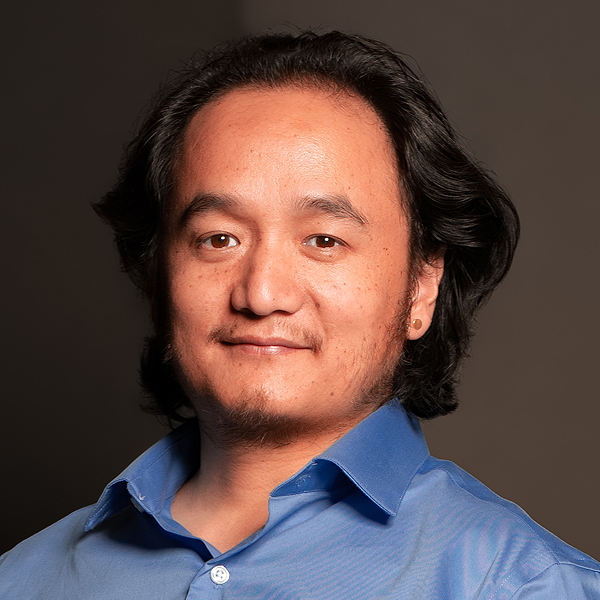
portrait by Bhawani Mahat, courtesy of the artist
About Muskan Balampaki

portrait by Bhawani Mahat, courtesy of the artist
The richness of Nepal
Muskan Balampaki (moosKAHN BALLahm-PAHkey) comes from Nepal (nayPAHL), a small country on the southern slopes of the Himalayas, tucked between Tibet to the north and India to the south. His home village in the Ilam (eeLAHM) district is roughly 100 miles southeast from Mount Everest, and roughly 300 miles east of Nepal’s capital city of Kathmandu. Just over Nepal’s eastern border from Muskan’s village is the small state of Sikkim (part of India) and beyond that, the tiny country of Bhutan (booTAHN) .
Situated at the far eastern edge of Nepal, Muskan’s home district is dramatically scenic, with towering mountains, fertile farmland, verdant forests, rushing streams, and alpine meadows full of wildflowers. That area has long been famed for its fine tea, as well as cardamom, ginger, and other crops. Home to respected schools and universities, important religious sites (Hindu, Kirat and Buddhist), and several distict ethnic groups, this region’s unique culture is rich with traditions, music, dance, and festivals.

The view from Ilam tea garden, Nepal, from Wikimedia Commons, licensed under the Creative Commons Share-Alike 3.0 license
A culture brimming with music
Muskan grew up in a culture and in a family where people regularly sang and made music together. His parents were musicians, and encouraged their three children to learn music, and coordinated monthly gatherings of all the musicians in the village. “And in Nepal, specific to our culture, every year we used to celebrate a festival, and they organized a cultural program every year. That requires practice! Every month we would practice a song.”
His father plays a Nepali instrument called a sarangi (SAHR-AHN-gee — gee, not jee), which is a bit like a violin, and had been inspired to learn folk music by his friends in school. His mother played some harmonium (he says harmony-um — not har-MOH-nee-um) and the Nepali drum called the madal (like “model”).
“I was growing up listening and looking at those kinds of musical activities in my house, and it kind of impressed me. And I started playing the instrument. I started loving the sounds, the folk music, the traditional music.”

photo courtesy of the artist
Muskan’s father not only played the sarangi, but could make the instrument as well. Muskan remembers his father cutting the big tree, and shaping the wood, and collecting a very specific leather, and getting hair for the bow from a horse’s tail. Muskan proudly shares, “My father brought that instrument [with him to America]: it’s 40 or 50 years [old], and it is here now.” Muskan’s parents came to live with him in January 2025.
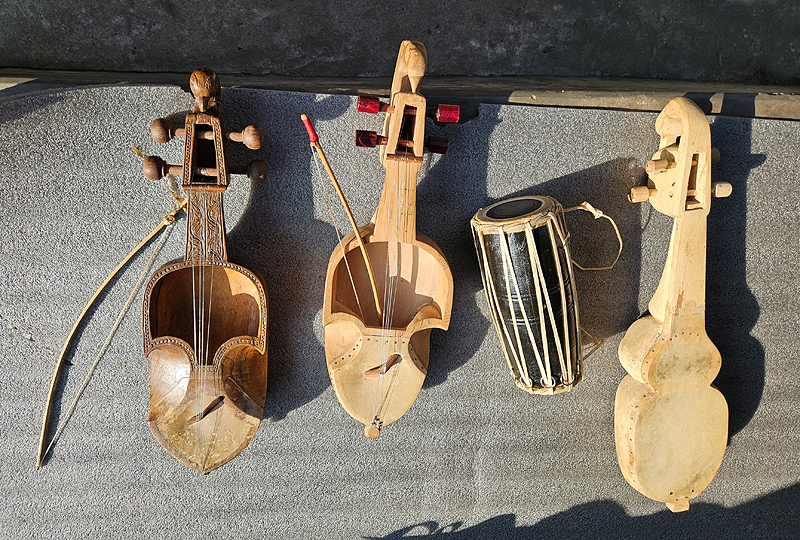
photo by Amy Skillman
As a child, Muskan learned to play the harmonium, a very common instrument in the Himalayas and the Indian subcontinent. As its name suggests, it creates a harmonious drone that supports singers and helps beginners develop vocal skills. It is used to accompany all kinds of music, from classical to popular folk music to Hindustani chants, and it can play melody too. A cousin of the accordion, with keyboard and bellows, it works and sounds like a portable pump organ.
Recognizing potential
Even as a young boy, Muskan had a talent for music, and he was often asked to perform at school. “You know, I still remember that,” he says. “They offered me the chance to play music and sing in front of a lot of people. And they would give me a new notebook or a pen as prize.”
Music was so important to him that his mother often had to remind him, late at night, to stop playing and go to bed, so he could get up for school the next day. If no one stopped him, he’d play until 4 in the morning.
But aside from right at bedtime, his parents nurtured his love of music. “Always my father encouraged me to learn.” And even though instruments and books were scarce in Nepal, “He used to bring me a lot of books and resources that would help me to learn. He bought me the instruments. And that’s how I practiced by myself.”
“When I was child, music was kind of like — it’s like my friend, and when I started growing up, going to middle school and high school, my teachers and my friends, they used to encourage me, like, ‘Hey, you have good potential with music, you might want to continue with this.’ ”
Learning how to learn
Music was not taught in schools when Muskan was young. Then, music was only seen as entertainment for the children. A youngster might study music privately if they could find (and afford) a tutor, but they couldn’t learn music in school. Still, Muskan was not deterred by his limited resources. He taught himself how to learn.
“It’s a gift from the gods, that I can feel that music. So, I did not have to struggle to learn to play an instrument.” He would listen to music on the radio, listen for how each instrument was played, and try to copy it. By high school, he had mastered harmonium and madal drum, and was asking for a violin so he could teach himself to play that. He even made himself a bamboo flute and taught himself to play it. “In our village there is lots of bamboo. And I cut that bamboo and I made a hole in it, and I figure it out myself.”
That ah-ha moment
Muskan was in 11th grade when he realized music would be his future. His village school went only to 10th grade, so he was a new student in the district high school and not many of the students or teachers knew him. When he performed folk music in a school cultural event, the audience was so surprised and delighted that they wouldn’t let the organizers move on to the next performance until Muskan had sung again. “That was the best moment in my life,” he says with a smile. But, although figuring out music on his own had given him a solid foundation, he knew he would need a more formal music education.
Learning and teaching...
After finishing high school, Muskan headed to Tribhuvan University in Kathmandu, where he earned his bachelor’s degree in music and business, and a master’s degree in Eastern Classical Music. His masters research focused on the folk music of his home region, with a special emphasis on the interconnections between Nepali folk music and Eastern classical music. He also studied privately with Ambar Gurung (composer of the Nepali national anthem!), who introduced Muskan to Western classical music forms and became Muskan’s mentor both in school and in the world of music. Gurung (who has since passed away) was one of a very few people familiar with both Eastern and Western classical music.
Muskan taught music in Kathmandu for about 15 years before coming to the United States. He had taught at various schools while studying for his degrees, and taught music at Kathmandu University for a few years after graduation. He also played keyboard for a variety of performing groups to earn extra money.
At the urging of an American musician who was a visiting scholar in Kathmandu at the time, Muskan applied for and was accepted into the Berklee School of Music in Boston, Massachusetts where he studied Western music for four years. It was in Boston that he met and married his wife, Chandra. They moved to California, where he found music students to teach and a job in food service at a hospital. When the hospital discovered his musical talents, they asked him to become became a music therapist.
...and fulfilling a dream

photo by Amy Skillman
Muskan dreamed of creating a school for Nepali music — not simply to teach students, but to create more musicians — and to create a larger community of people who love this music and want to share it. His dream is now reality. And it’s right here in Central PA.
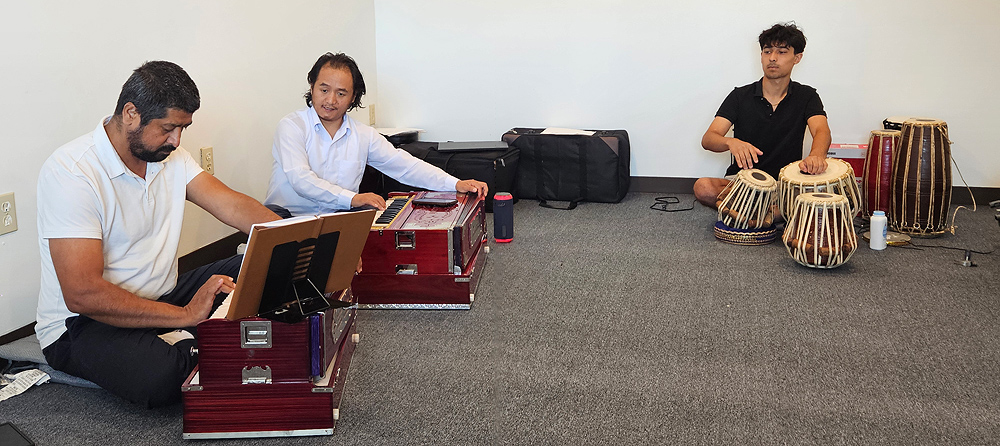
photo by Amy Skillman
Founding a school: a dream come true
Muskan says, “It was my plan and dream to open [a school] in a specific location. That way, it will be easier to reach out to people, and they will feel more comfortable to see and meet and listen and practice the music [instead of coming to my home]. And that’s why we decided to run the school. And my family and my friends, they supported me.”
That dream come true is GEMCA MUSIC (he says JEM-sah) on Union Deposit Road in Harrisburg. It includes a practice room, a small performance/practice space, and a studio. For now, most classes are in the evenings or on weekends, to accomodate Muskan’s daytime work as compliance director for a home health agency.
With the school in a central location, he lost a few students who don’t have the means to travel so far, but he is eager to build back to 50 students. Most of his students are learning Nepali instruments such as the harmonium, tablas, and the bamboo flute, but some are learning piano/keyboard. He is proud to have about a dozen students who can play really well, even though they are still youngsters.
Muskan wants his students to be able to play and appreciate Nepali music, but also have a solid foundation in Western music so that they can participate in other musical communities, from school orchestras to garage bands.

photo by Amy Skillman
East and West, ancient and fresh
Muskan’s training at the Berklee School of Music added Western classical music to his repertoire — not only the music, but the structure, rhythm, tonality, and the learning styles. He uses the Sa-re-ga-ma method of teaching, which is similar to the western Do-re-mi, to teach the intervals of notes in a scale, especially for teaching singing. But the similarities end there. To put it simply:
Western classical music is oriented around written music : compositions that can be replicated by performers who can read the notation. It puts chords and harmonies at the forefront, and has orderly structures of scales and note values.Eastern classical music is oriented around oral tradition: an individual musician’s skill and creativity at manipulating a complex melody. Its 7-tone and 5-tone systems are difficult to capture as notes on a scale. At its core, it is based on folk music.
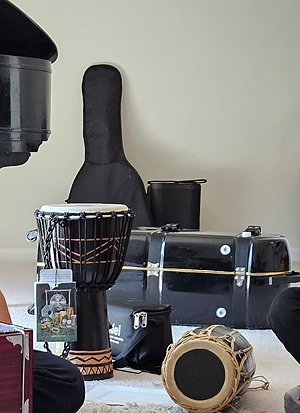
photo by Amy Skillman
Muskan composes music for his community, drawing on both Eastern and Western structures to create music that expands Nepali folk music while staying true to Nepali culture and tradition. “Basically I compose music that has to go to the heart of the people. I always compose based on my traditional folk music. Because, you know, that comes with our blood, and people can feel, ‘Oh, this is my music.’ And that should be ‘feel-able’ for all ages, old or young, because they grew up listening to those kind of musical environments, traditional culture.”
Muskan especially enjoys elaborating on traditional folk tunes, improvising around the original melody to bring a new interpretation to the old tune, much like Mozart did with ‘Twinkle, Twinkle, Little Star.’ He demonstrated with a Nepali festival song. The traditional melody is still recognizable, but the elaborations make it new again.
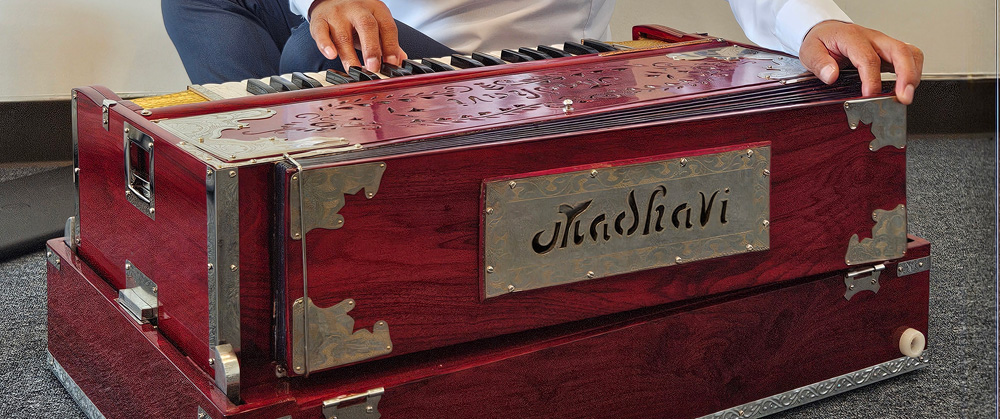
photo by Amy Skillman
Music for healing
Muskan observes, “A lot of immigrants came with their own PTSD. Music could help them to recover. And if I play music from the 90s, from Nepal or Bhutan, they can go back to that time, and remember... Everyone can sing and dance and enjoy, and relieve that stress, and start to recover.” He enjoys offering concerts of traditional folk music at GEMCA to bring people together as a community, and to ease some of the pain of losing their homes and their old lives.
Muskan is especially concerned about the elders in the local Nepali community (and it’s much the same for younger people) because their lives are now so disconnected. It’s very different from their cultural experience in Nepal, where people would go to each other’s homes, celebrating with food, music, and singing. “All the village was like one house. There are those kinds of attachments. And here, they are losing those attachments.” Bringing pleasant memories to the surface is restorative and healing, and so is bringing people together to make connections.
Having enjoyed his work as a music therapist in California, Muskan has continued to do that occasionally as a volunteer, when his schedule allows. “I would say it’s medicine, you know? It’s medicine for everyone.” Even the very ill can feel the music and enjoy it, and Muskan enjoys it too. Music is restorative for him as well as for his listeners.
“...if I am feeling down or stressed, I go to the instrument, the harmonium, and I sing. That’s how I can release my stress. As human beings, there are so many ups and downs going on. But that’s how the music is. It’s positive vibes.”
Heading in the right direction
Even though Muskan is a teacher, he is still a learner too. “Even though I’ve been teaching music for almost 20 years, whether harmonium or even the Western music, I still wanna learn, you know? I feel like I’m a student still. I’m still looking for research so I can learn more about music. I always want to learn. And I want to collaborate with other musicians and create music that people can feel in their heart. Not to make money ... but to create music people can enjoy and love and, you know, really feel that music.”
“I grew up listening and playing music, and that set me on the right path to live my life,” he muses. “That’s why I’m here, as a musician and teacher. Music gave me the right direction... I have so many friends, and some of them went in the wrong direction. Why didn’t I? That was because of music.” He wants that for the Nepali children growing up here.
The irony is that many people in his village thought music was going to take him “the wrong way.” They would tell his parents, ‘Your son only plays and sings music; he isn’t going to amount to anything. Music is not a good profession.’ But his parents saw beyond the neighbors' misconceptions. They saw and supported a love that would eventually lead to study, research, and teaching. Creating a school to teach music is fulfilling not only his own dream, but also his parents’ hopes for his future. And now that they are living with him, he hopes he can persuade his father to teach a bit too.
For Muskan, music is a gift he wants to share. He wants people to feel the music in the same way he feels it. And he is moving toward that goal every day, teaching Nepali folk and classical music, as well as Western music, to Nepali children and anyone else who wants to learn.

Sigismund von Dobschütz’s photo of musicians playing tabla and harmonium in Kathmandu, Nepal, from Wikimedia Commons, licensed under the Creative Commons Share-Alike 3.0 license



Brand icons for Facebook, YouTube, Instagram and other social media platforms are the trademark of their respective owners. No endorsement is implied.